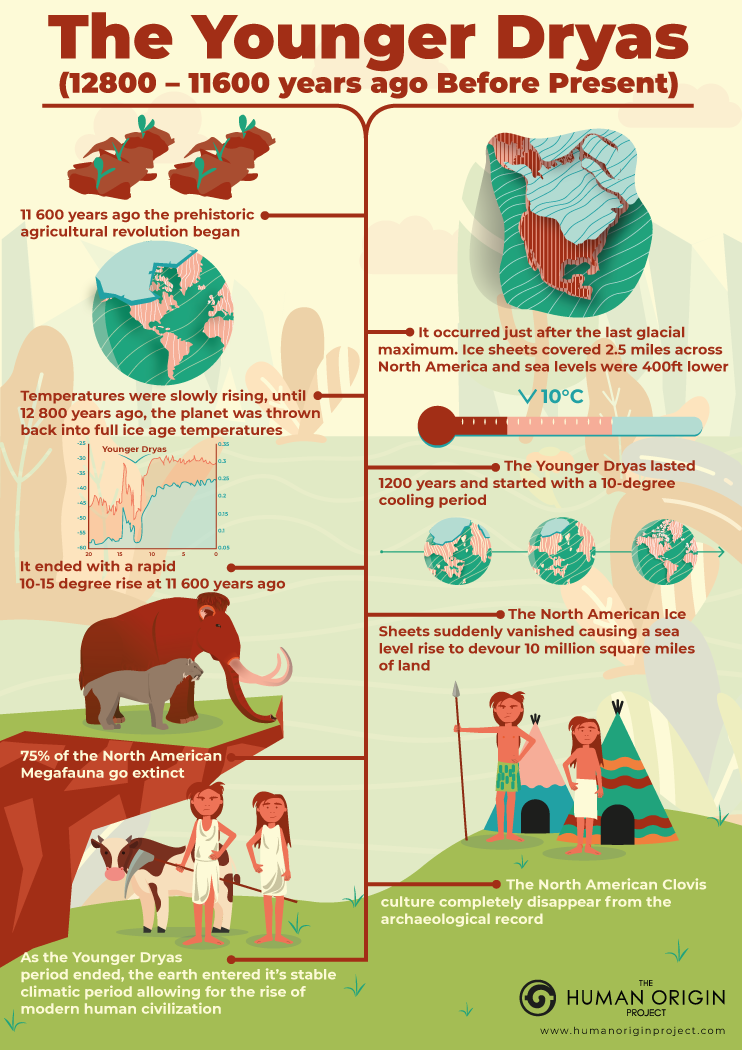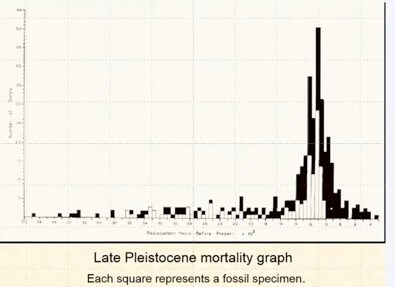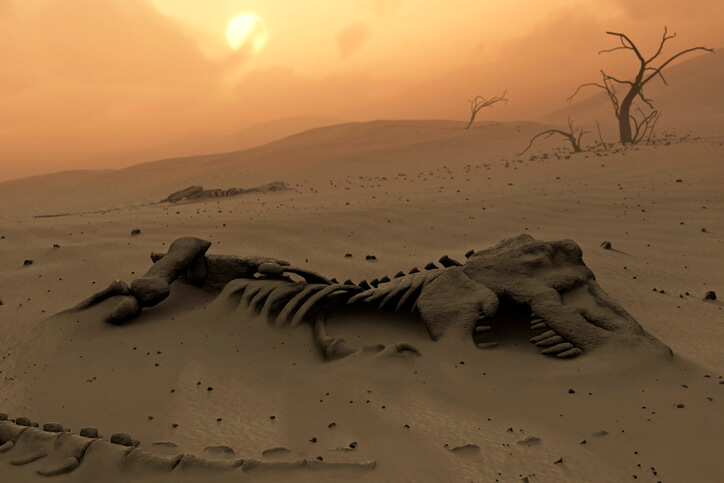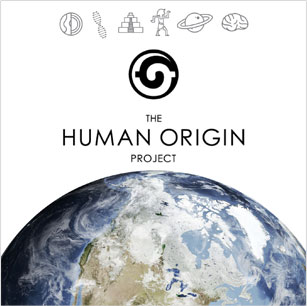Over millennia earth has seen and lost countless living species. None is more well-known than the disappearance of the dinosaurs 65 million years ago. For many epochs, mega-reptiles dominated the planet until an asteroid crashed into the Gulf of Mexico sending these creatures into the history books. Such large spans of times make these events difficult to comprehend. Most people may not realize that a comparable event occurred in the prehistoric period before human civilization arises. This is the story the Younger Dryas event and the megafauna extinction.
It is hard to picture just 12 000 years ago earth was at the end of the last Ice Age. North America was a swampy marshland and was home to the largest population of megafauna found anywhere on the planet. Today these lumbering land creatures are mainly confined to herds across the plains of Africa.
How did such a dominant array of species disappear? It took one of the most unprecedented sets of conditions seen on earth, those that ended the last great ice age.
The Younger Dryas event describes the climatic period as the earth moved out of the ice age.
Geological evidence is revealing how conditions during the Younger Dryas remodelled our planet. It created weather so extreme that it also reduced human societies living on the planet at this time.
Importantly, it marks the prehistory period just before human civilization arises.
It may explain why traces of megafauna were sparse in the scientific records. There are many theories as to what caused the termination of these giant land mammals.
Together with the mounting geological data of the events that occurred during this period, a new picture of what caused the megafauna extinction is becoming more evident.
The vanishing North American megafauna
“At the time of maximum continental glaciation, the northern hemisphere supported an abundant and varied fauna of large mammals… The fauna included giant beavers, mammoths, mastodons, elk, most species of perissodactyls, many even-toed forms, and ground sloths. These species maintain their numbers quite well but experienced rapid decline and extinction in the period, when the climate became milder. What might have been the cause for the extermination of these large Pleistocene mammals?”
– Harold L. Levin, Professor of Geology, 1982.
12900 years ago prehistoric earth was exiting the last Ice Age. North America was a haven for large land mammals. Here roamed roughly 50% of all animals larger than 32kgs and all species above 1000kgs.

Then, in a geological blink of an eye, during the Younger Dryas period, North America lost 33 distinct genera of mammals. These were mainly the large megafauna who had previously thrived in the area for thousands of years.
It equated to 75% of all mega mammals living on the earth during the ice age. They all vanished from the planet.
The list of the megafauna lost in North America alone is vast.
It includes:
- Horses
- Camels
- Giant sloths
- Tapirs
- Giant armadillos
- Elephants
- The short-faced bear
- American lions
- Dire wolves
- All species of mammoth
- Mastodons
- The giant beaver
The extinction event was also not isolated to large mammals. Nineteen genera of birds also disappeared. There is also evidence of animals all over the planet changing their migration patterns and habits to adapt to the new climate and earth changes that were taking place.
The speed of North American megafauna extinctions is unseen in recent earth history. The graph below outlines the Younger Dryas extinctions compared to the fossil record of the past 50 000 years.
Each square represents the finding of a fossil species. At the end of the last ice age, roughly 120 species of mammals became extinct during the Younger Dryas period.
This spike in fossil remains coincides exactly with the time of the melting of glaciers, rising sea levels, and massive temperature changes of the Younger Dryas event.

The Late Pleistocene Mortality Graph: The Younger Dryas Extinction Rates aligns with the prehistoric end of the Ice Age.
A Prehistoric Disappearing Act
“What, then has exterminated so many species and whole genera? The mind is at first irresistibly hurried into belief of some great catastrophe; but thus to destroy animals, both large and small, in southern Patagonia, in Brazil, on the Cordillera of Peru, in North America, up to Behring’s Straights, we must shake up the entire framework of the globe.”
– Charles Darwin
Now, what caused the megafauna to disappear?
There is no widely accepted theory as to what was the primary cause of the Younger Dryas extinctions. Currently, human overhunting is the forerunning theory.
However, there are some serious flaws showing up with this idea.
Here are five problems with the human hunting theory:
1) Raw volume of animals
The theory has mainly been applied in isolated incidences and without accounting for all animals lost. The number of mammoths alone was estimated between 5 and 12 million. A staggering number which suggests other factors played a prominent role in their extinction.
The sheer body mass to hunt to extinction is an anomaly in itself. At roughly 6 tons each that is roughly 60 million tons of wooly mammoth to be hunted and killed. Then add the many other species of megafauna. Could humans cause this level of hunting driven extinction?
2) Variations
Is it a stretch to imagine humans as the sole cause for the termination of all species at once? It may, for instance, explain why one species was hunted into extinction. What of the vastly different types of megafauna present at the last ice age?
Hunting a mastodon and saber tooth tiger, for example, are two very different styles of prey. The vast disappearance appears to be a barrier to the hunting hypothesis.
3) History
Humans and mega mammals had coexisted together for thousands of years.
There are studies of human causes for extinctions of mammals in the fossil record. These, however, are only isolated events, with the majority of fossils records showing no sign of human interference.
4) Time span
The disappearance of megafauna fossils appears very rapidly at the Younger Dryas event of 12000 years ago.
Or in other terms, a geological blink of an eye.
5) It coincided with the loss of humans.
If humans were the dominant eradicator of species, why would they to disappear in the same period?
The Clovis people who lived amongst megafauna in North America also vanished during the Younger Dryas period.
Was the Younger Dryas event a cataclysm?
For the dinosaurs, it took a meteor to the Gulf of Mexico to wipe them from the earth. Catastrophic events are linked to extinction episodes throughout earth’s periods.
An alternative to the hunting theory looks at conditions of the earth during this period. It could explain why the megafauna were removed so abruptly.
The Younger Dryas punctuates a remarkable shift in climate conditions on earth. Evidence now reveals the extremity of changes that occurred in this period. So extreme perhaps, to contribute to the disappearance of so many large species.
These have been documented through the research into the ice core sampling in Greenland. Scientists have mapped the history of the earth’s climate over the past 250 000 years. Measurements of the Younger Dryas period, reveal extreme temperature changes of 10 degrees in 10 years in some cases.
Additionally, were the global sea level rise of 400 feet. It coincides with the sudden melting of the North American ice sheet.
Scientists have not agreed what caused these events on earth. However, the catastrophic conditions of the Younger Dryas period point to a sudden and fatal blow to the megafaunal populations all over the planet.
Conclusion:
If there is anything to learn from the megafauna extinction, it is that earth’s conditions can swiftly become unexpectedly harsh for its inhabitants. The Younger Dryas was a prehistoric period when many of earth’s species disappeared from the planet.
The turbulent conditions of the Younger Dryas event point to a much more cataclysmic demise of the North American Megafauna, rather than a gradual human-driven extinction.
Earth’s periods are defined with extinctions of species of animals to make way for the next wave. The loss of megafauna, just before the rise of human civilization, may have been due to violent climatic change.
Now it’s up to you.
Were the North American megafauna driven to extinction by human hunting? Or were they wiped out by a cataclysm?
Further reading:




























